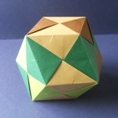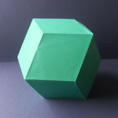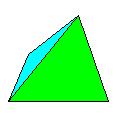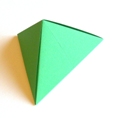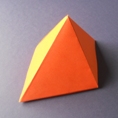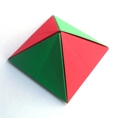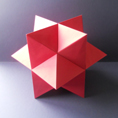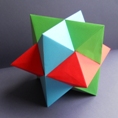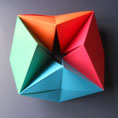| When I
was writing the first edition of my book, Mathematical
Origami, I found that I wanted to include several
polyhedra for which there did not appear to be an
established mathematical name. The characteristics of
these polyhedra were that their faces were either
109.28/70.32 rhombuses or 70.32/54.84/54.84
(1:sqrt3/2:sqrt3/2) triangles, which can be obtained by
folding the 109.28/70.32 rhombus in half lengthways, or a
mixture of the two. For want of better, I stole the word
'rhombic' from the name of the rhombic dodecahedron,
whose faces are, of course, 109.28/70.32 rhombuses, and
applied it to the other polyhedra as well, thus creating
the terms rhombic tetrahedron, rhombic octahedron etc and
the general term rhombic polyhedra to describe them as a
group. I justified this usage to myself on the grounds
that the triangular faces occurred in pairs, which if
flattened would come back to a 109.28/70.32 rhombus.
Somewhat to my surprise, my publisher raised no objection
to this.
I was expecting
that I would receive a barrage of criticism for this
usage and that someone would soon point out to me a
better terminology to use for these forms, but, so far,
neither of these things have happened. I still, however,
expect a better terminology to emerge at some stage.
Pro tem then I
shall continue to use the term rhombic polyhedra,
although in a slightly developed sense, to mean the set
of those polyhedra which can be combined with other
identical polyhedra to build a rhombic dodecahedron and
which have at least some faces that are either
109.28/70.32 rhombuses or 70.32/54.84/54.84
(1:sqrt3/2:sqrt3/2) triangles. The members of this
interesting set of polyhedra are illustrated below. All
of them will fill space.
This definition
deliberately excludes many polyhedra whose faces are
70.32/54.84/54.84 (1:sqrt3/2:sqrt3/2) triangles, and
particularly those that can be made by putting together
three-sided pyramids, or sunken pyramids, whose faces are
such triangles and similar designs whose faces are or
include 109.28/35.36/35.36 (sqrt2:sqrt3/2:sqrt3/2)
triangles, which can be obtained from the 109.28/70.32
rhombus by folding it in half in the other direction. If
these forms were to be included within the definition of
rhombic polyhedra then we would be in a situation where
there were, for instance, three separate forms that could
quite correctly be called rhombic hexahedra and three
more that could quite correctly be called rhombic
dodecahedra. This is clearly nonsensical and so I have
adopted the narrower definition given above. I have not
invented any general name for the excluded forms.
It is worth
pointing out that although the 109.28/70.32 rhombus has
diagonals in the proportion 1:sqrt2 I have avoided using
the term silver rhombus since that would suggest that
this rhombus has properties similar to the silver
rectangle and silver triangle, which it does not.
The classic book
Mathematical Models, by H M Cundy and A P Rollett
contains a net for the rhombic pyramid, although the
authors do not give it a name. They do, however, use the
term rhombic polyhedra in a different sense from mine as
a general term for polyhedra whose faces are rhombuses,
ie the cube, the rhombic dodecahedron and the
triacontahedron. I apologise for introducing confusion by
using this term in another way.
The third edition
of this book, published in 1960, also contains the
information that a Mr Dorman Luke, otherwise unknown to
me, has found that all three stellations of the rhombic
dodecahedron can be arrived at by adding what I call
rhombic pyramids to the rhombic dodecahedron in
successively larger numbers. These forms fall outside my
definition of rhombic polyhedra but this is not a
difficulty as they already have their own established
names. I have, incidentally, found that by continuing the
process of adding rhombic pyramids to the third
stellation it is eventually possible to arrive at a much
larger rhombic dodecahedron than the one used to initiate
the process.
|
